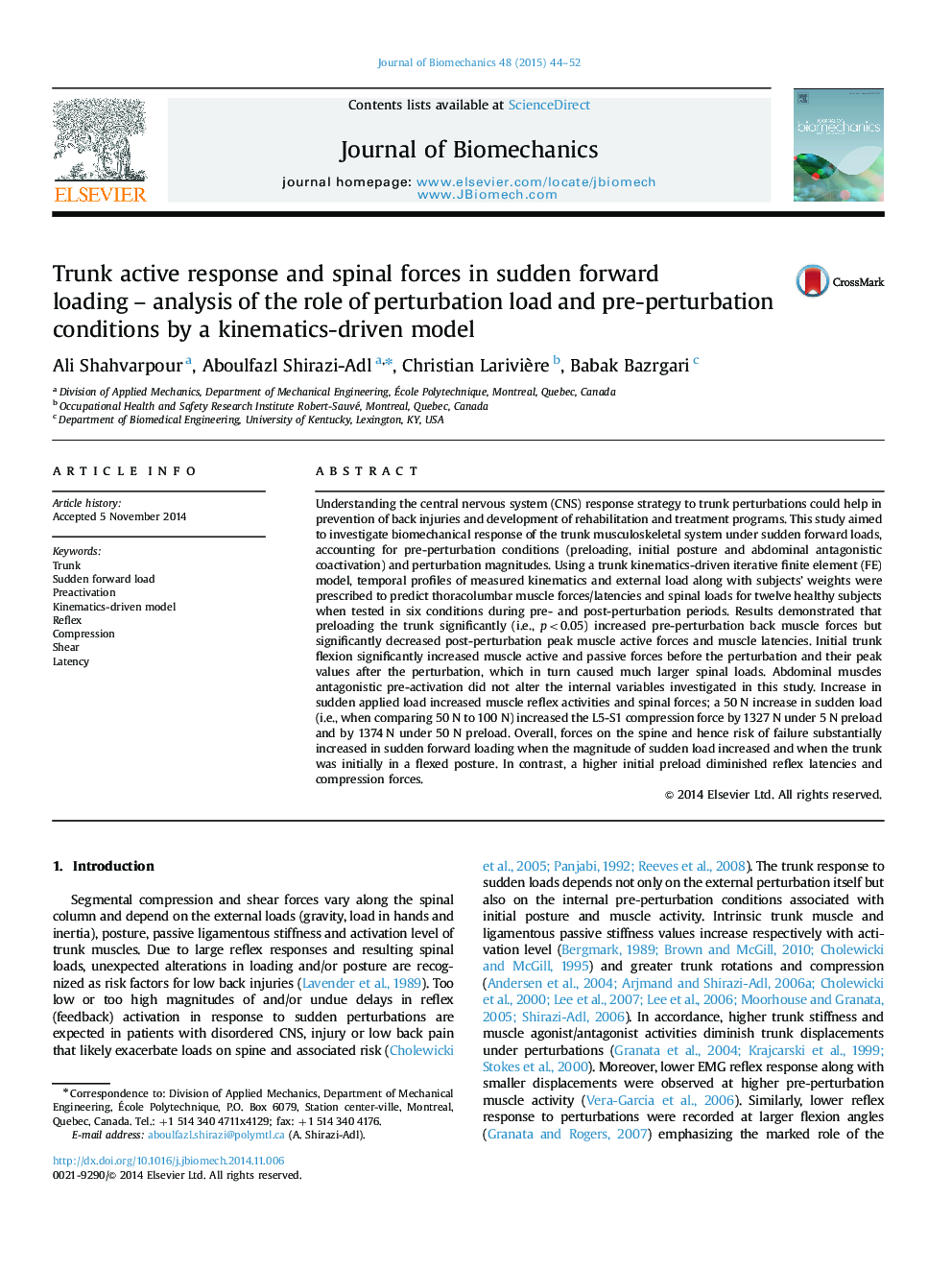| کد مقاله | کد نشریه | سال انتشار | مقاله انگلیسی | نسخه تمام متن |
|---|---|---|---|---|
| 10431653 | 910221 | 2015 | 9 صفحه PDF | دانلود رایگان |
عنوان انگلیسی مقاله ISI
Trunk active response and spinal forces in sudden forward loading - analysis of the role of perturbation load and pre-perturbation conditions by a kinematics-driven model
ترجمه فارسی عنوان
پاسخ فعال تنه و نیروهای ستون فقرات در بارگیری ناگهانی جلو - تجزیه و تحلیل نقش بار تخلخل و شرایط پیش تشدید با یک مدل حرکتی مبتنی بر سینماتیک
دانلود مقاله + سفارش ترجمه
دانلود مقاله ISI انگلیسی
رایگان برای ایرانیان
کلمات کلیدی
موضوعات مرتبط
مهندسی و علوم پایه
سایر رشته های مهندسی
مهندسی پزشکی
چکیده انگلیسی
Understanding the central nervous system (CNS) response strategy to trunk perturbations could help in prevention of back injuries and development of rehabilitation and treatment programs. This study aimed to investigate biomechanical response of the trunk musculoskeletal system under sudden forward loads, accounting for pre-perturbation conditions (preloading, initial posture and abdominal antagonistic coactivation) and perturbation magnitudes. Using a trunk kinematics-driven iterative finite element (FE) model, temporal profiles of measured kinematics and external load along with subjects' weights were prescribed to predict thoracolumbar muscle forces/latencies and spinal loads for twelve healthy subjects when tested in six conditions during pre- and post-perturbation periods. Results demonstrated that preloading the trunk significantly (i.e., p<0.05) increased pre-perturbation back muscle forces but significantly decreased post-perturbation peak muscle active forces and muscle latencies. Initial trunk flexion significantly increased muscle active and passive forces before the perturbation and their peak values after the perturbation, which in turn caused much larger spinal loads. Abdominal muscles antagonistic pre-activation did not alter the internal variables investigated in this study. Increase in sudden applied load increased muscle reflex activities and spinal forces; a 50Â N increase in sudden load (i.e., when comparing 50Â N to 100Â N) increased the L5-S1 compression force by 1327Â N under 5Â N preload and by 1374Â N under 50Â N preload. Overall, forces on the spine and hence risk of failure substantially increased in sudden forward loading when the magnitude of sudden load increased and when the trunk was initially in a flexed posture. In contrast, a higher initial preload diminished reflex latencies and compression forces.
ناشر
Database: Elsevier - ScienceDirect (ساینس دایرکت)
Journal: Journal of Biomechanics - Volume 48, Issue 1, 2 January 2015, Pages 44-52
Journal: Journal of Biomechanics - Volume 48, Issue 1, 2 January 2015, Pages 44-52
نویسندگان
Ali Shahvarpour, Aboulfazl Shirazi-Adl, Christian Larivière, Babak Bazrgari,
